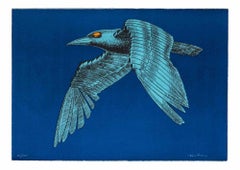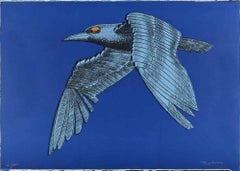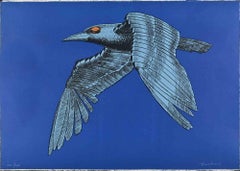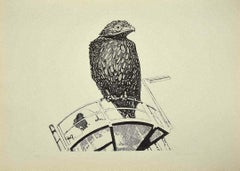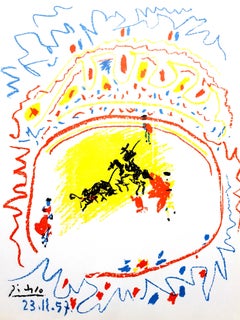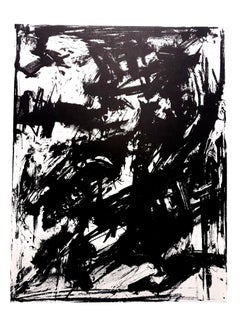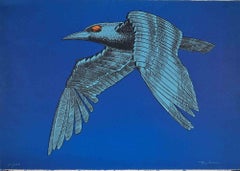Aldo Turchiaro Animal Prints
to
1
4
Overall Width
to
Overall Height
to
4
1
8
194
161
118
94
5
1
4
5
5
4
2
1
4
1
5
Artist: Aldo Turchiaro
Bird - Lithograph by Aldo Turchiaro - 1980
By Aldo Turchiaro
Located in Roma, IT
Bird is a lithograph by Aldo Turchiaro, realized in 1980.
Hand-signed on the lower right.
Numbered, edition V/XXV.
Good conditions except for aged margins.
The artwork represents...
Category
1980s Contemporary Aldo Turchiaro Animal Prints
Materials
Lithograph
Bird - Lithograph by Aldo Turchiaro - 1980
By Aldo Turchiaro
Located in Roma, IT
Bird is a lithograph by Aldo Turchiaro, realized in 1980.
Hand-signed on the lower right.
Numbered, edition XII/XXV.
Good conditions except for aged margins.
Category
1980s Contemporary Aldo Turchiaro Animal Prints
Materials
Lithograph
Bird - Lithograph by Aldo Turchiaro - 1980
By Aldo Turchiaro
Located in Roma, IT
Bird is a lithograph by Aldo Turchiaro, realized in 1980.
Hand-signed on the lower right.
Numbered, edition XIV/XXV.
Good conditions except for aged margins.
The artwork represen...
Category
1980s Contemporary Aldo Turchiaro Animal Prints
Materials
Lithograph
Bird - Original Lithograph on Paper by Aldo Turchiaro - 1980
By Aldo Turchiaro
Located in Roma, IT
Bird is an original lithograph by Aldo Turchiaro in 1980.
hand-signed on the lower right.
numbered, edition XX/XXV.
good conditions except for aged margins.
The artwork represents a mechanical...
Category
1980s Modern Aldo Turchiaro Animal Prints
Materials
Lithograph
Bird - Etching by Aldo Turchiaro - 1974
By Aldo Turchiaro
Located in Roma, IT
Bird is an etching by Aldo Turchiaro in 1974.
Hand-signed on the lower right.
Numbered, edition 51/99.
Good conditions except for aged margins.
The artwork represents a bird with...
Category
1970s Contemporary Aldo Turchiaro Animal Prints
Materials
Etching
Related Items
Pablo Picasso - La Petite Corrida - Original Lithograph
By Pablo Picasso
Located in Collonge Bellerive, Geneve, CH
Pablo Picasso - Original Lithograph
La Petite Corrida (The Small Bullfight)
1958
Edition of 2000, unsigned
Published in the journal XXe Siecle
Dimens...
Category
1950s Modern Aldo Turchiaro Animal Prints
Materials
Lithograph
$3,942
H 12.6 in W 9.85 in D 0.04 in
Emilio Vedova - Original Lithograph
By Emilio Vedova
Located in Collonge Bellerive, Geneve, CH
Emilio Vedova - Original Lithograph
Abstraction
1961
From the art revue XXe Siecle
Dimensions: 32 x 24
Edition: G. di San Lazzaro.
Unsigned and unumbered as issued
Category
1960s Modern Aldo Turchiaro Animal Prints
Materials
Lithograph
CIRCUS Signed Lithograph, Big Top Tent, Animals, Trapeze Act, Acrobats, Clowns
Located in Union City, NJ
CIRCUS is a hand drawn original lithograph by the Argentine born woman artist Ivel Weihmüller printed using traditional hand printmaking techniques on archival paper 100% acid free. ...
Category
1970s Contemporary Aldo Turchiaro Animal Prints
Materials
Lithograph
Untitled (Horses)
By Laura Owens
Located in New York, NY
Los Angeles-based artist, Laura Owens' horse prints often incorporate her characteristic style, which challenges traditional assumptions about figuration and abstraction . Her work f...
Category
Early 2000s Contemporary Aldo Turchiaro Animal Prints
Materials
Etching, Aquatint
Pablo Picasso - Jeu de la Cape - Lithograph
By Pablo Picasso
Located in Collonge Bellerive, Geneve, CH
Lithograph by Picasso
Atelier Mourlot.
Paper: Vélin.
Dimensions : 9 5/8 x 12 7/16 inches
Reference: Bloch 1015
Picasso is not just a man and his work. Picasso is always a legend, ...
Category
1960s Modern Aldo Turchiaro Animal Prints
Materials
Lithograph
“Le Picador II” from the book Sabartés
By Pablo Picasso
Located in Collonge Bellerive, Geneve, CH
“Le Picador II” from the book Sabartés, “A los Toros avec Picasso“ 1961, from the edition of unknown size, printed by Mourlot Frères, Paris, published by Andre Sauret, Monte Carlo.
...
Category
1960s Modern Aldo Turchiaro Animal Prints
Materials
Lithograph
Resting. Contemporary Figurative Etching Print, Female Nude, Polish artist
By Pawel Zablocki
Located in Warsaw, PL
Contemporary figurative etching print by Polish arist living in Canada, Pawel Zablocki. Print depicts a woman laying on her side with head resting on her arm. Artwork is monochromati...
Category
2010s Contemporary Aldo Turchiaro Animal Prints
Materials
Paper, Etching
$188 Sale Price
20% Off
H 5.91 in W 8.27 in
SHARING THE CHORES Signed Lithograph, Farm Women Chickens Geechee Gullah Culture
By Jonathan Green
Located in Union City, NJ
SHARING THE CHORES is a hand drawn, limited edition lithograph by the acclaimed Charleston SC artist JONATHAN GREEN printed using hand lithography techniques on archival Arches paper...
Category
1990s Contemporary Aldo Turchiaro Animal Prints
Materials
Lithograph
Human Behaviour and Animals and Existentialism full set of 8 prints
By David Shrigley
Located in London, GB
David Shrigley
Human Behaviour and Animals and Existentialism, 2022
The complete suite of 8 digital posters on 200gsm Munken Lynx wove paper
27 3/5 × 19 7/10 in / 70 × 50 cm
Limit...
Category
2010s Contemporary Aldo Turchiaro Animal Prints
Materials
Lithograph
$3,340
H 27.56 in W 19.69 in
Leo by Marcelo Martin Burgos - Lithograph, animal, childhood, imagination, wings
By Marcelo Martin Burgos
Located in Paris, FR
Leo is a lithograph (2 colours, gold leaf on Fabriano 50% cotton 300 g paper) by contemporary artist Marcelo Martin Burgos, dimensions are 35 × 50 cm (13.8 × 19.7 in).
The lithograp...
Category
2010s Contemporary Aldo Turchiaro Animal Prints
Materials
Gold Leaf
untitled (horseman)
By Maximino Javier
Located in Palm Springs, CA
This whimsical and surreal etching by Mexican artist Maximino Javier, dated 1984, embodies his unique visual language that blends fantasy, folklore, and satire. Executed with intrica...
Category
1980s Contemporary Aldo Turchiaro Animal Prints
Materials
Etching
“Europa and the Bull”
By Alvar Sunol Munoz-Ramos
Located in San Francisco, CA
You have to hand it to the bull. Not just taking Europa with his unassailable power (he is Zeus in disguise, after all) he brings along a retinue for his seduction of the beautiful P...
Category
1980s Modern Aldo Turchiaro Animal Prints
Materials
Paper, Lithograph
Previously Available Items
The Mechanical Bird - Original Lithograph by Aldo Turchiaro - 1970s
By Aldo Turchiaro
Located in Roma, IT
The mechanical bird is an original artwork realized by Aldo Turchiaro in the 1970s.
Mixed colored lithograph.
Hand signed on the lower right margin....
Category
1970s Contemporary Aldo Turchiaro Animal Prints
Materials
Lithograph
H 19.69 in W 27.56 in D 0.04 in
Aldo Turchiaro animal prints for sale on 1stDibs.
Find a wide variety of authentic Aldo Turchiaro animal prints available for sale on 1stDibs. If you’re browsing the collection of animal prints to introduce a pop of color in a neutral corner of your living room or bedroom, you can find work that includes elements of blue and other colors. You can also browse by medium to find art by Aldo Turchiaro in etching, lithograph and more. Much of the original work by this artist or collective was created during the 20th century and is mostly associated with the modern style. Not every interior allows for large Aldo Turchiaro animal prints, so small editions measuring 20 inches across are available. Customers who are interested in this artist might also find the work of Sergio Barletta, Leo Guida, and Alberto Mastroianni. Aldo Turchiaro animal prints prices can differ depending upon medium, time period and other attributes. On 1stDibs, the price for these items starts at $251 and tops out at $279, while the average work can sell for $265.
